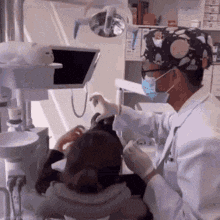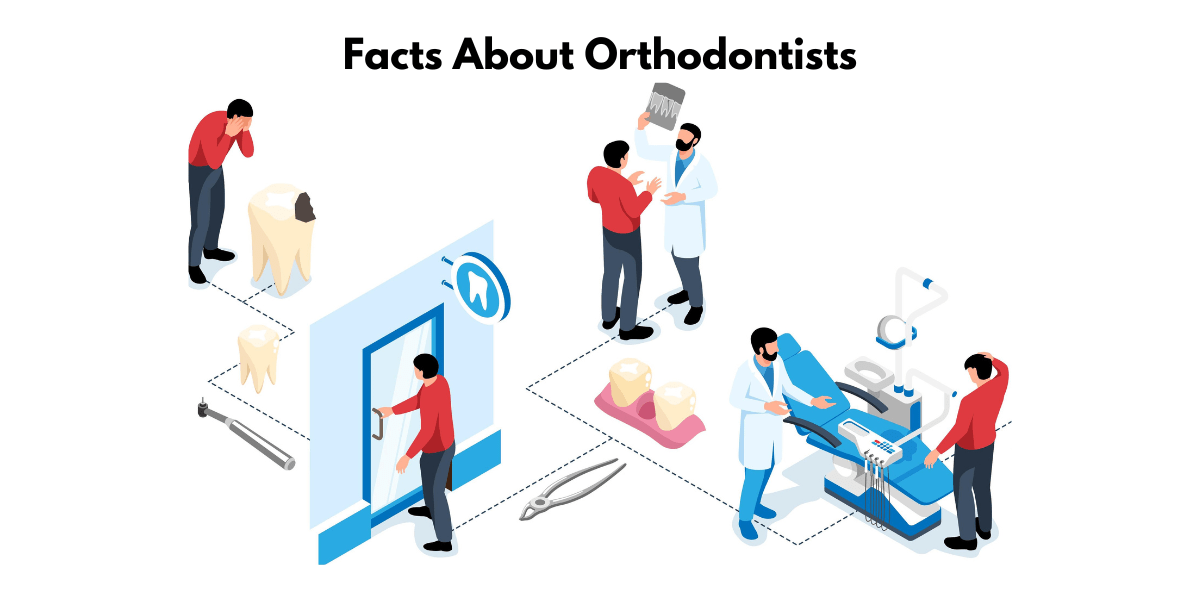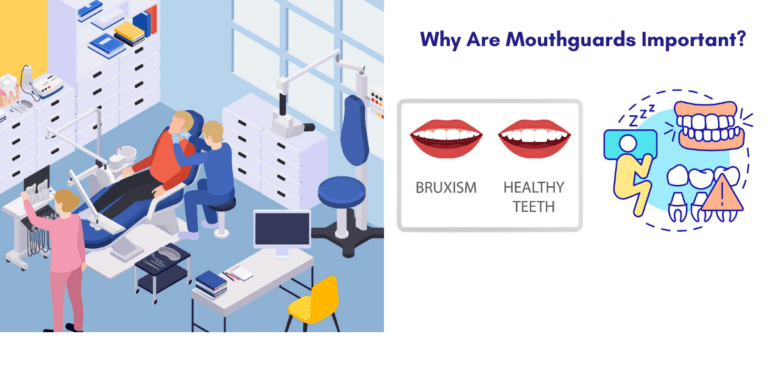What is an Orthodontist? [10 facts] you need to know about orthodontists
What is an orthodontist?
An orthodontist is a dental specialist who has undergone extensive training and has the skills to diagnose, prevent, and treat irregularities in the jaw and teeth.
An orthodontist is a dentist for braces; they use tools such as Invisalign to straighten crooked teeth and correct misaligned jaw structures.
Orthodontists are also trained to identify potential problems when conditions are left untreated and can treat patients of all ages.
This specialized training helps to create healthy, stunning smiles and ensures that teeth and jaws are correctly aligned for optimal dental health and appearance.
What is orthodontics?
Orthodontics or orthodontia is a specialized area of dentistry that focuses on diagnosing, preventing, and treating dentofacial abnormalities or problems with the size, position, or orientation of the teeth and jaw.
Common orthodontic treatments involve braces, retainers, and other appliances to create a fantastic and aligned smile.
Orthodontic treatment and regular dental check-ups are effective ways to achieve and maintain good oral health for people of all ages.
Orthodontist vs Dentist
Orthodontist vs dentist: understanding the differences between these two dental specialists is essential for making informed decisions about your oral health.
Orthodontists are experts in all orthodontic care options and technologies for children, teens, and adults.
While dentists are experts in general dental care and maintenance for all ages, as well as cosmetic dental procedures such as tooth whitening, veneers, and crowns.
Ultimately, dentists and orthodontists can help you improve your oral health, but selecting the right specialist will depend on your individual needs and goals.

What are the tasks of an orthodontist?
An orthodontist is a specialist in dentistry and is responsible for diagnosing, preventing, and treating dental and facial abnormalities.
Their training includes braces, Invisalign, retainers, and more to help straighten the teeth, correct misaligned jaw structure, and create beautiful, functional smiles.
Orthodontists work with people of all ages, from children to adults, to improve their oral health and overall well-being.
They also supervise facial growth (jawline and bite) in children and perform teeth-straightening surgeries.
To become an orthodontist, a person has to commit to at least 10-12 years of extensive education, training, and fellowships.
Orthodontists are incredibly skilled professionals, and their work has been proven to help people achieve and maintain excellent oral health.
1. A specialist in the diagnosis and treatment of dental irregularities
Dental irregularities refer to any misalignment or misplacement of the teeth and jaw from their normal position.
Orthodontists specialize in diagnosing, preventing, and treating these irregularities, including crooked teeth, gaps between teeth, overbites, underbites, overcrowding, and jaw misalignment.
Orthodontists use braces, retainers, and other appliances to change the position of teeth in the mouth and create a healthy bite.
Regular dental check-ups and orthodontic treatment are great ways to maintain oral health.
Here’s a list of dental irregularities that requires an orthodontic treatment:
- Overbites
- Underbites
- Crossbites
- Open bites
- Crowding
- Spacing
- Protrusion
- Asymmetry
- Impacted teeth
2. Consultation with patients regarding orthodontic treatment
A consultation regarding orthodontic treatment is a meeting between a patient and an orthodontist to discuss the diagnosis, prevention, and treatment of dental and facial abnormalities.
During a consultation, the orthodontist will examine the patient’s teeth and jaw structure and discuss the treatment options best suited to the patient’s needs, such as braces, retainers, or clear aligners.
The goal of the consultation is to create a treatment plan that can help improve the patient’s bite, smile, and overall oral health.
3. Checking x-rays and other scans to assess the condition of the teeth and jaws
An orthodontist uses in-person exams and 2D or 3D x-rays, photos, and teeth molds to develop an individualized treatment plan.
During the examination, the orthodontist will take x-rays and other scans to identify any existing issues and potential issues that may arise.
The scans and images help the orthodontist diagnose and treat teeth and jaw misalignments.
They also allow the orthodontist to determine the type of appliance best suited for a particular patient’s condition.
From there, the orthodontist can create a personalized treatment plan to correct the misalignment.

4. Applying braces and other orthodontic devices to correct jaw alignment
Applying braces and other orthodontic devices to correct jaw alignment involves a range of activities, such as:
- Attaching metal, ceramic, or plastic square bonds to the teeth, which may include brackets, wires, springs, or elastics
- Placing headgear to help move teeth into alignment with pressure from outside the mouth
- Fitting and adjusting dental appliances such as retainers, palate expanders, or clear aligners
- Making necessary modifications to the patient’s bite patterns
- Placing and securing surgical screws, plates, or wires to support the jaw bone in cases of severe underbite or overbite
- Regularly adjusting braces and aligners every four to 10 weeks
- Extracting teeth in certain cases
- Monitoring the patient’s progress throughout the treatment period
5. Regular follow-up visits to monitor the progress of the orthodontic treatment
Regular follow-up visits are necessary to monitor the progress of orthodontic treatment.
Depending on the severity of the condition, orthodontic treatment generally takes one to two years.
During the treatment, orthodontists will typically schedule follow-up visits every four to 10 weeks to ensure teeth are moving in the right direction and make any necessary adjustments.
Additionally, your orthodontist may recommend more frequent visits to check your teeth’ progress and clean around your orthodontic appliances.
This helps reduce the risk of cavities and other oral health problems.
6. Advice on how to take care of the teeth and gums
Here are some tips to remember:
- Make sure to visit an orthodontist by the age of 7. This will give you the best opportunity for an effective orthodontic treatment plan.
- Have regular check-ups and cleanings with your dentist throughout your orthodontic treatment. Your dentist will be able to monitor your oral health and advise on maintaining good oral hygiene.
- Practice good oral hygiene. Brush your teeth thoroughly twice daily, floss, and use an antiseptic mouthwash. Also, avoid sugary and starchy snacks, which can lead to tooth decay.
- Wear orthodontic appliances as prescribed. Invisalign aligners, braces, and other orthodontic appliances should be worn as directed by your orthodontist.
- Protect your teeth and gums from injury. Wear a mouthguard while playing sports to protect your teeth and gums from damage.
- Avoid hard, crunchy, and sticky foods. These types of foods can damage your orthodontic appliances and should be avoided.
- Visit your orthodontist regularly. Regular check-ups with your orthodontist will ensure you receive the best treatment possible.
7. Treatment of jaw pain caused by orthodontic appliances
Jaw pains are a common symptom of misaligned teeth and jaws and can be caused by various conditions.
They can result from temporomandibular joint disorders (TMJ), overcrowding of the teeth, size differences between the upper and lower jaw, or irregular bite patterns.
Jaw pains can also be caused by tooth grinding, orthodontic treatment, or injuries to the teeth.
Treatment of jaw pain often involves braces or dental appliances, such as metal, ceramic, or plastic square bonds, attached to the teeth with wires or springs.
In more severe cases, jaw surgery may be recommended to fix the misalignment, which involves cutting and stabilizing the bone with titanium or bioresorbable plates and screws.
8. Surgical orthodontics for more complex cases
The tasks of an orthodontist for more complex cases of surgical orthodontics include:
- Diagnosing and treating facial and dental irregularities such as malocclusions (bad bites)
- Supervising facial growth (jawline and bite) in children
- Creating a treatment plan that includes braces and retainers
- Performing teeth straightening surgery
- Installing dental appliances such as braces, palatal expanders, orthodontic headgear, or Herbst appliances
- Using specialized methods to change and adjust the position of the teeth
- Examining patients to ensure jaw and tooth irregularities are not beginning to form
- Improving the patient’s bite
- Helping to restore a patient’s ability to speak, chew, and eat properly
- Ensuring that teeth and jaw are set correctly

9. Certification and training by the standards of the profession
Certification and training following the profession’s standards are essential for dentists and orthodontists to practice.
Dentists require four years of undergraduate school and four years of dental training, culminating in passing rigorous written and clinical licensing exams.
Once certified, dentists are generalists who can diagnose, treat, and prevent various oral problems.
Obtaining a Certificate of Completion of Specialty Training (CCST) also allows an orthodontic specialist to be registered under the General Dental Council (GDC).
10. Keeping up to date with the latest orthodontic techniques and products
It is important to stay current on the latest orthodontic techniques and products as they constantly evolve.
Orthodontists typically receive 10 to 11 years of additional training beyond high school and need to be certified by the American Association of Orthodontists.
As a result, they must stay informed of the most recent developments in the field, which require frequent updating.
This includes keeping abreast of new treatment options and appliances such as braces, clear aligners, retainers, and palate expanders and learning about advances in digital scans and x-rays.
Regular check-ups with your orthodontist are also important to ensure optimal results from your orthodontic care.
Benefits of having an orthodontist
Orthodontists are specialized dental professionals who have undergone extensive education and training in orthodontics, diagnosing, preventing, and treating dental and facial abnormalities.
Orthodontic treatment can not only help improve the aesthetic look of a person’s smile but can also provide a variety of functional and health-related advantages.
Straightening your teeth can improve chewing and speech function, reduce the risk of cavities and gum disease, and ease pain related to TMJ disorder.
An orthodontist can help get your mouth and teeth into the best possible shape and improve your oral health.
1. Orthodontists have specialized training and expertise in diagnosing and treating jaw, teeth, and facial alignment problems
Orthodontists are highly trained and educated dental specialists who have completed an additional three years of university training in orthodontics, facial growth, development, biology, and biomechanics.
This is beyond the four-year bachelor and four-year degrees in dentistry.
They specialize in preventing, diagnosing, and treating teeth and jaw irregularities, providing a wide range of treatment options such as braces and Invisalign.
Orthodontists are skilled in correcting existing conditions and identifying potential problems that may develop when left untreated.
2. Orthodontists can provide more complex treatment options, such as jaw realignment surgery and full-mouth braces
Orthodontists provide various treatment options to help straighten teeth and correct misaligned bites.
These include braces, clear aligners, retainers, and palate expanders.
3. Orthodontists have access to advanced equipment and technology, which can improve the results of the treatment
Access to advanced equipment and technology in orthodontic treatment can greatly improve the treatment results.
Modern technology has allowed for more effective and efficient treatment plans, with shorter treatment times and less discomfort.
For instance, low-level laser therapy (LLLT) and vibratory devices can reduce pain during treatment, while brainwave music and cognitive behavioral therapy can help improve the patient’s overall experience.
4. Orthodontists are trained to assess and diagnose oral problems and give advice on how to prevent them
Orthodontic treatment can help restore confidence in your smile and improve your overall quality of life.
Straightening your teeth can improve chewing and speech function, while aligning your bite can reduce your risk of cavities, gum disease, and other oral health issues.
Orthodontic treatment can also ease pain related to TMJ disorder and help with misaligned jaws or bite problems that can cause pain or clicking while chewing.

5. Orthodontists can provide treatment for adults as well as children and can tailor the treatment to each patient’s needs
Orthodontists provide a variety of treatments for both adults and children to correct dental issues, including teeth crowding or spacing, abnormal or missing teeth, protruding teeth, and mismatched jaws.
6. Orthodontists have access to continuing education and are up to date on the latest treatments
Orthodontic treatments offer functional and health-related advantages such as improved chewing and speech, reduced risk of gum disease and cavities, and ease of pain related to TMJ disorder.
Plus, with an aligned bite, you can achieve a beautiful, healthy smile that can boost your confidence and help you live a happier life.
7. Orthodontists can provide emotional support to patients, as well as advice on managing pain and discomfort during treatment
An orthodontist can provide a range of emotional support to patients, depending on the individual’s needs.
Classification:
- Education and information: An orthodontist is knowledgeable in facial irregularities and tooth movements and can provide advice and answers to any patient’s questions about their treatment.
- Psychological support: Orthodontists may also be able to provide psychological support to patients. This could include helping the patient overcome any fears or anxieties associated with the treatment and providing guidance and reassurance throughout the process.
- Emotional support: Orthodontists can also provide emotional support to patients by providing a listening ear and offering encouragement. This can help to reassure the patient that the treatment is beneficial and that the result will be worth it.
8. Orthodontists can provide consultation regarding diet and oral hygiene during treatment
An orthodontist can provide dietary advice and instructions on tooth brushing and flossing techniques.
During the consultation, the orthodontist will discuss the importance of good oral hygiene practices and ways to maintain them while wearing braces or aligners.
They will provide education on the types of food to avoid and which are best to include in a balanced diet.
They may also recommend specialty products or tools to help patients care for their teeth, such as interdental brushes and tongue scrapers.
9. Orthodontists have access to networks and resources that can help patients find financing for their treatment
Having orthodontic treatment can be expensive, but various financing options are available to help patients cover the cost.
Many orthodontists work with third-party finance companies to provide patients access to lower-interest-rate loans or payment plans tailored to their needs.
In addition, some orthodontic offices even offer in-house payment plans that may help reduce the financial burden.
By consulting with an orthodontist, patients can learn about the financing options available and choose the one that best fits their budget.
10. Orthodontists are licensed through the American Dental Association and are subject to regular audits and reviews
Orthodontists in the United States are required to maintain licensure through the American Dental Association (ADA).
To do this, they must pass a national or state licensing exam and then complete two to three years of an accredited orthodontic program.
Once certified, the orthodontist must then renew their certification every ten years.
To ensure high levels of professionalism, the ADA performs regular audits and reviews of orthodontists to ensure they adhere to the highest standards of care.

How to find the right orthodontist for you?
Let’s discuss the steps to help you find the right orthodontist that suits your needs, so you can feel confident in your decision and make the best choice for your smile.
Step 1: Research types of orthodontists available
The first step to researching your orthodontic needs is understanding the different types of orthodontists available.
There are two main types of orthodontists.
The first type of orthodontist is the general orthodontist, who typically specializes in braces and aligners.
The second type of orthodontist is a specialist orthodontist, who is qualified to provide a wider range of services, such as jaw surgeries and specialized treatments.
Researching the difference between an orthodontist and a dentist is a great place to start to ensure you make the best decisions for your smile.
Step 2: Ask family and friends for referrals
Asking family and friends for referrals is an excellent way to find an orthodontist that you can trust.
Word of mouth is powerful, and your friends and family will likely be able to provide you with valuable insight into the quality of the orthodontic work, the customer service, and the overall experience.
Step 3: Look online for results from previous patients
When selecting an orthodontist, it is important to look online for reviews and results from previous patients.
Seeing the positive results of previous patients gives you confidence in the capabilities of the orthodontist and the quality of their work.
Step 4: Check out the orthodontist’s website, blog, and social media profiles
The orthodontist’s website, blog, and social media profiles can help you find the right one to achieve your desired results.
By researching an orthodontist’s qualifications and credentials, you can ensure they have the necessary education and expertise to properly diagnose the underlying cause of your bite issues and determine the best treatment plan to fix it.
Step 5: Make sure the orthodontist is qualified for the condition you’re seeking treatment for
Do ample research to ensure the orthodontist of your choice is qualified to treat your condition.
Most orthodontist deal with common dental irregularities. However, special cases may require special treatment.
Step 6: Check out the orthodontist’s qualifications, experience, and credentials
When considering whether to pursue orthodontic treatment, evaluating the orthodontist’s qualifications, experience, and credentials is important.
Ensuring they have completed the right qualifications, have the necessary experience, and possess the right credentials is essential.
Be sure to check for certification from the Commission on Dental Accreditation and ask for their portfolio and references before making any decisions.
It is also important to find out what kind of technology and resources the orthodontist has access to and the treatment options available.
Step 7: Read reviews from other patients
Reading reviews from other patients can help you find the right orthodontist for you by allowing you to understand the experiences of those who have gone before you.
Reviews provide insight into the quality of the services provided, giving potential customers an idea of what to expect when they visit a particular practice.
By reading reviews, patients can also understand the orthodontist’s professionalism and ability to provide quality care.

Step 8: Consider their lifestyle preferences when choosing an orthodontist
When choosing an orthodontist, it’s important to consider your lifestyle preferences.
Make sure you choose an orthodontist that can give you additional knowledge on better care for your teeth that suits your situation.
Step 9: Ask questions during the consultation
When you visit an orthodontist for a consultation, it is important to ask questions to ensure you understand all aspects of the treatment and receive the best possible care.
Here are some questions to ask your orthodontist during your consultation:
- What type of orthodontic treatment do you recommend for my condition?
- What are the risks, benefits, and potential outcomes of the treatment?
- How long will the treatment take?
- What is the cost of the treatment?
- How often will I need to see the orthodontist for check-ups?
- What is the best way to maintain my teeth and gums during the treatment?
- What should I do if I experience any discomfort or pain?
- Are there any special instructions I should follow while undertaking treatment?
- How often will I need to visit the practice for regular cleanings?
- Are there any other treatments you think may be beneficial for me?
- What Is Pediatric Dentistry? Your Guide to Child-Friendly Dental Care - August 27, 2024
- What is an Orthodontist? [10 facts] you need to know about orthodontists - April 13, 2023
- Dental Advice: Everything You Need to Know about Clear Aligners - February 28, 2022







